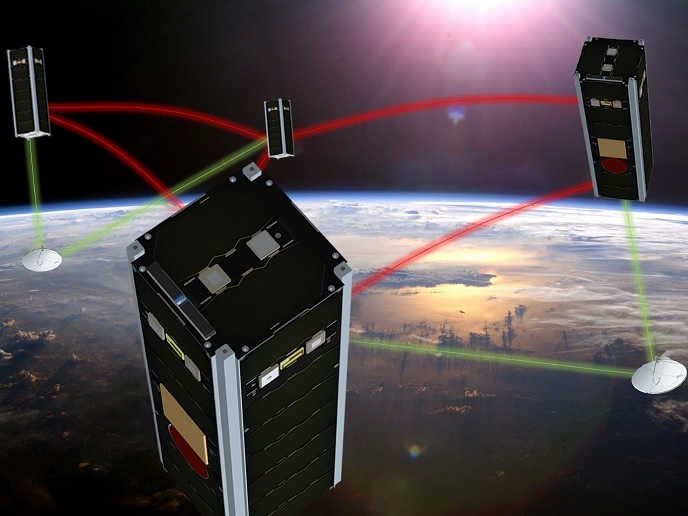Advancing the feasibility of self-organising small satellite formations
Satellites used for communication, positioning and Earth observation have historically been large, complex and expensive. But that’s starting to change. Like computers and telephones, satellites are getting smaller and smaller – with some weighing just 1 kg. Since costs for the launcher are proportional to a satellite’s mass, the miniaturisation of satellites is helping to lower mission costs. As a result, these satellites, known as pico-satellites, could soon work in formation and complement today’s larger, more expensive satellites. In 2020, researchers with the EU-funded NetSat (Networked Pico-Satellite Distributed System Control) project are set to demonstrate the world’s first self-organising, three-dimensional formation control by four in-orbit pico-satellites. To learn more about this breakthrough – and what it means for the future of satellite-based services – we sat down with Klaus Schilling. Schilling is professor and Chair of Robotics and Telematics at the University of Würzburg and coordinator of the ERC grant, which is being implemented at the Centre of Telematics, an independent research institute in Würzburg, Germany.
What is the main objective that the NetSat project set out to achieve?
Schilling: There’s a major paradigm shift happening within spacecraft engineering. The single, large, multifunctional satellites of today are being replaced by groups of small satellites. In the near future, instead of sending one large satellite into orbit, we’ll see larger numbers of networked, cooperating small satellites in space. The potential of distributed sensor networks in orbit with large baseline distances between the satellites will enable multi-point measurements and improve characterisation of the Earth’s space environment, as well as Earth observation and telecommunications. However, before this can happen, we must first understand how to get these small satellites to operate as a team, make them fly in formation, and have them communicate and coordinate with each other. That’s what the NetSat project is about: creating a technology demonstrator to prove the feasibility of a formation of small satellites that could serve as a platform for scientific experiments and, potentially, commercial applications.
What will be achieved during the in-orbit demonstration?
Prior to the demonstration, the project’s focus was on developing the key control technologies needed to realise three-dimensional formation flight. For the first time ever, the in-orbit demonstration will validate this by controlling all four satellites in a self-organising formation. Currently, almost all multi-satellite systems are used as a constellation, with each satellite being individually tele-operated from a ground control centre. What we’re trying to do is to get the satellites to work as a team, or fly in formation, with relative attitudes and positions measured and exchanged via inter-satellite links. On this basis, control actions will be coordinated to avoid collisions and enable optimal geometries for the given observation tasks.
How is this development a ‘game changer’?
Being able to control a group of pico-satellites and have them work as a team opens the door to a wave of innovative applications in Earth observation and telecommunications. For example, by enabling the simultaneous observations of targeted areas from different perspectives, Earth observation systems will be able to generate innovative 3D images of the Earth’s surface and atmosphere. There’s also the forthcoming www.telematik-zentrum.de/cloudct (CloudCT mission), which involves a formation of 10 small satellites that will use computed tomography principles to characterise the interior of clouds as a means of improving climate predictions.
How has the project advanced the state of the art for pico-satellites?
To ensure the safe operation of a group of satellites within near vicinity of each other, we developed an autonomous collision avoidance scheme. This feature will, for example, help ensure that these satellites don’t collide with the dramatically increasing amount of debris that is floating around space. Many applications also need to point their high precision instruments or antennae towards a targeted area and be able to continuously adapt their orientation towards an observed object to compensate for their high speed of motion. For this purpose, we developed power-efficient miniature reaction wheels specifically designed to provide an unmatched level of turning accuracy for very small satellites. Most importantly, we implemented a suitable small satellite system, with each satellite weighing only 4 kg yet still capable of being fully equipped with all the necessary subsystems for formation operations. These include an attitude determination and control system, an orbit determination system, a communications system capable of inter-satellite communication and satellite-to-ground communication, as well as electrical propulsion for orbit control and maintaining the formation.
What will NetSat’s legacy be?
The complex, interdisciplinary software and hardware for operating groups of small satellites developed within NetSat is now ready for the launch, currently planned for June 2020. This system will encourage future distributed sensor network-based applications for new Earth observation approaches. This, along with the collision avoidance schemes, will be NetSat’s legacy.
Any future plans following NetSat?
Following a successful NetSat in-orbit demonstration, the next step is to take advantage of the achieved formation flying capabilities for innovative application missions. Several projects have launched, each leveraging the NetSat system in the Earth observation context. For example, the Telematics earth Observation Mission (TOM), is using a formation of three small satellites to generate 3D images of the Earth’s surface by photogrammetric methods.
Countries
Germany



